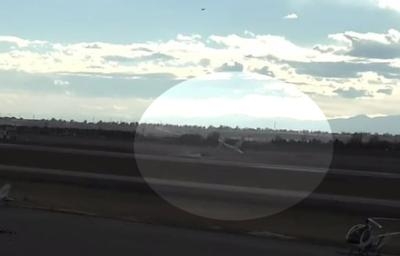Wed, Feb 04, 2015
Pilot Told NTSB He Thought He'd Allowed Enough Time For Them To Dissipate
This pilot thought he'd done everything right, as is evidenced by the NTSB's preliminary report. But at the end of the day, the pilot was seriously injured and the Cirrus SR20 he was flying was badly damaged. It's a rare instance in which a security camera caught the entire accident sequence, and we thought it would be instructional for our readers to see.

According to the NTSB, on December 5, 2014, about 1435 central standard time, a Cirrus SR20 airplane, N407ND, impacted terrain during approach at the Fort Collins-Loveland Municipal Airport (FNL), near Fort Collins, Colorado. The solo student pilot was seriously injured and the aircraft was substantially damaged. The aircraft was registered to and operated by Cirrus LLC under the provisions of 14 Code of Federal Regulations Part 91 as an instructional flight. Day visual meteorological conditions prevailed for the local flight, which departed without a flight plan.
The student pilot stated that he entered the traffic pattern at FNL for a full stop landing on Runway 33. He observed a Sikorsky UH-60 helicopter on downwind and delayed his turn to base until the helicopter was on final, abeam his position. While on final, the student pilot adjusted his aim point to land long, as he was concerned with wake turbulence and wanted to land beyond the helicopter's touchdown point. Just prior to landing, he encountered turbulent air and attempted to go around. The airplane subsequently impacted terrain and cartwheeled, which resulted in damage to the fuselage and wings.
An airport surveillance camera at FNL captured the accident airplane approaching the runway about 30 seconds in trail of the UH-60 helicopter.
At 1435 the weather observation station at FNL reported the following conditions: wind 110 degrees at 3 knots, visibility 10 miles, clear sky, temperature 14 degrees Celsius (C), dew point 4 degrees C, altimeter setting 30.22 inches of mercury.
(Image from YouTube video)
More News
Airport Marking Aids Markings used on runway and taxiway surfaces to identify a specific runway, a runway threshold, a centerline, a hold line, etc. A runway should be marked in ac>[...]
"It is extremely difficult, if not impossible, for manned aircraft to see a drone while conducting crop-enhancing and other aerial applications at low altitudes and high speeds. We>[...]
Aero Linx: The Skyhawk Association The Skyhawk Association is a non-profit organization founded by former Skyhawk Pilots which is open to anyone with an affinity for the A-4 Skyhaw>[...]
“The T-54A benefits from an active Beechcraft King Air assembly line in Wichita, Kansas, where all required METS avionics and interior modifications are installed on the line>[...]
Aero Linx: Aerostar Owners Association The Association offers the Aerostar Owner a unique opportunity to tap an invaluable source of information concerning the care and feeding of >[...]
 ANN's Daily Aero-Term (04.28.24): Airport Marking Aids
ANN's Daily Aero-Term (04.28.24): Airport Marking Aids Aero-News: Quote of the Day (04.28.24)
Aero-News: Quote of the Day (04.28.24) ANN's Daily Aero-Linx (04.28.24)
ANN's Daily Aero-Linx (04.28.24) Aero-News: Quote of the Day (04.29.24)
Aero-News: Quote of the Day (04.29.24) ANN's Daily Aero-Linx (04.29.24)
ANN's Daily Aero-Linx (04.29.24)



